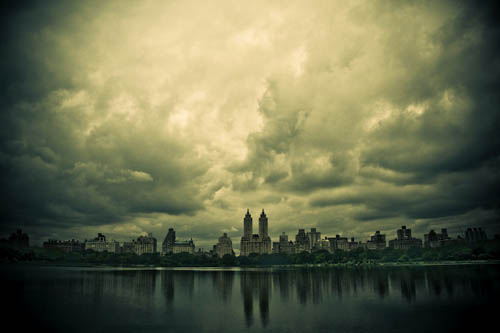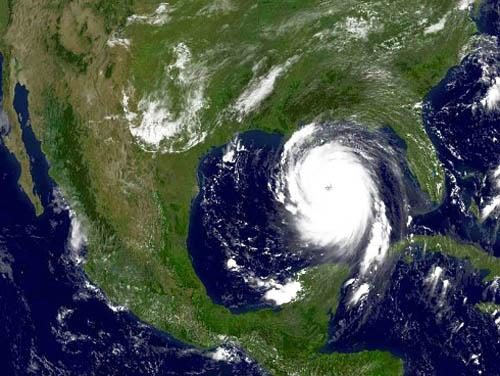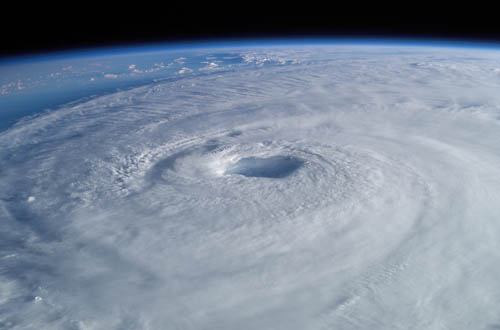Windy City
 [Image: "Storm Clouds Over Central Park" by Joseph Bergantine].
[Image: "Storm Clouds Over Central Park" by Joseph Bergantine].Do urban landscapes act as attractors for storms and hurricanes? "New research shows that rough areas of land, including city buildings and naturally jagged land cover like trees and forests, can actually attract passing hurricanes," a study claimed last week.
It works because the whole landscape acts as a kind of vortex or chimney: "Rough cityscapes and forests trap air. This compresses the air and forces it up into the atmosphere, adding energy to the storm and pulling the center of the hurricane toward the rough region. As a result, a city can cause a hurricane to swerve from its predicted path by as much as 20 miles."
- "Cities impose greater friction on the swirling flow because of the tall buildings," said Johnny Chan, a professor of meteorology at the [City University of Hong Kong]. "Our results show that tropical cyclones tend to be 'attracted' towards areas of higher friction. So it is possible that cities could cause tropical cyclones to veer towards them."
 [Image: Hurricane Katrina approaches New Orleans—possibly attracted there, a new study suggests, by the "rough cityscape" of the greater metropolitan region].
[Image: Hurricane Katrina approaches New Orleans—possibly attracted there, a new study suggests, by the "rough cityscape" of the greater metropolitan region].I'm reminded of the storm-storage islands described in Greek mythology—for instance, one of my favorite architectural designs of all time, from Virgil's Aeneid, a place called "Aeolia, the weather-breeding isle," where all the winds of the world are stored:
- Here in a vast cavern King Aeolus
Rules the contending winds and moaning gales
As warden of their prison. Round the walls
They chafe and bluster underground. The din
Makes a great mountain murmur overhead.
High on a citadel enthroned,
Scepter in hand, he molifies their fury,
Else they might flay the sea and sweep away
Land masses and deep sky through empty air.
In fear of this, Jupiter hid them away
In caverns of black night. He set above them
Granite of high mountains—and a king
Empowered at command to rein them in
Or let them go. (Book 1, 75-89)
Or it's the breezy future of street-cleaning. An alternative to fireworks on the 4th of July. A side-effect of urban planning just waiting to be weaponized. An opportunity for urban scale climatological re-engineering brought to you by Trane.
 [Image: Hurricane Isabel seen from space].
[Image: Hurricane Isabel seen from space].We saw long ago, for instance, that "many of the skyscrapers in Shanghai could become quite dangerous" due to the high winds they've started to generate. Indeed, "concerns have been raised about the strong and thus damaging winds that are result[ing] from the dense population of skyscrapers so central to the metropolis."
The city, in other words, is generating its own weather. Add this new study—with cities like New Orleans and Miami and New York literally attracting hurricanes to themselves—and the burgeoning field of urban architectural meteorology just got a lot more urgent (and interesting).
(Thanks to Tim Maly for the link!)





Comments are moderated.
If it's not spam, it will appear here shortly!
I wrote a story just the other week that's thematically very similar to that of King Aeolus - http://spenceria.wordpress.com/2010/08/12/dispatches-from-the-wilds-of-proseambique-ripples/ - just goes to show there really are no new ideas, I suppose...
This is so stupid. Throw a dart at a map. Did you hit a city? Yes, oh, that's right, there are cities everywhere. The possibility that you won't hit a city is slim to nothing. There, I just save hundreds of thousands of research dollars.
I love the potential of collecting and storing wind for our own "weather theme parks" - I think maybe you've mentioned something like that in the blog or in the book before?
Just read about a "Superwind Galaxy" on The Dark Side of the Force - a series of events within an entire galaxy produces superwinds which shoot gases millions of light years into space...
http://unknownskywalker.tumblr.com/post/1051832577
Also @Anonymous - I reckon if you pinned up a map of the world you could blindly throw a dart at it several times over without hitting any densely populated areas, never mind cities with sufficiently tall buildings to affect the direction of hurricanes.
Asides from the huge water bodies and oceans, there are massive stretches of plains, steppes, ice caps, deserts, national parks and so on that are not populated or very, very sparsely populated. I'd say the fact that hurricanes do actually hit densely populated areas with such regularity is incredibly remarkable – certainly worthy of research?
I think the guy wo said trow a dart and you hit and the guy who said throw a dart and you won't are both idiots. all you need to think about is that hurricanes, volcanoes and earthquakes all happen in the same region. Why? because there are certain parameters that control and produce such events. hurricanes= warm water, warm easterly winds (Sahara) and you get a hurricane. volcano and earthquakes are due to shifting and subducting plate tectonics. London hasn't been hit by a hurricane yet it such a large city, neithertoronto neither madrid. hurricanes have a track and follow more or less similar tracks each year, which are controlled coriolis force and jetstream winds and ITCZ. also if the stupid american government lets the stupid american people live in hurricaneprone regions then good because they deserve it for being ill-educated and ignorant.
Post a Comment